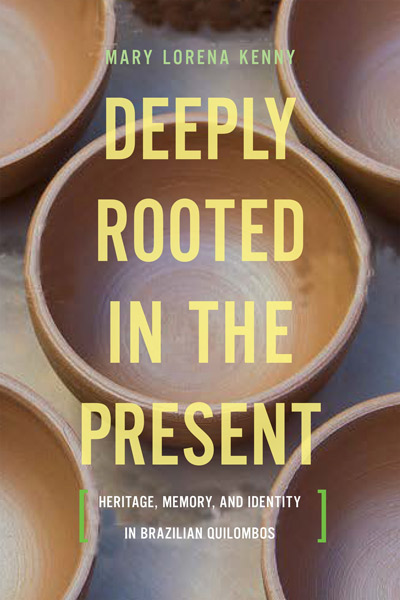- Apply
- Visit
- Request Info
- Give
Eastern Professor Authors Book on Maroon Communities in Brazil
Written by Jordan Corey
Published on February 14, 2019

Mary Lorena Kenny, professor of anthropology at Eastern Connecticut State University, recently authored “Deeply Rooted in the Present: Heritage, Memory, and Identity in Brazilian Quilombos.” Kenny held a book talk on Jan. 31 to celebrate and discuss her research.
There are an estimated 4-6,000 quilombo communities, also known as “maroon communities,” in Brazil. Their inhabitants – quilombolas – are federally recognized descendants of self-ascribed, traditional Black settlements. They are descendants of enslaved persons who escaped to freedom and established settlements in remote mountain locations or dense tropical terrains.
Brazil imported more than five million slaves over the course of 300 years – the highest number in the Americas. Kenny said the legacies of slavery and colonialism are manifested in inequities that contemporary quilombolas face in terms of access to healthcare, schooling and basic infrastructure. Three quarters of quilombola families live in extreme poverty and receive public assistance.
A legal decree in Brazil’s 1988 Constitution guarantees quilombolas collective land titles as a type of reparation, but there is strong opposition to this policy. Opponents argue that slavery ended long ago, making the issue irrelevant, while others assert that the land grants are exclusionary, or that slavery never existed in the area. Throughout “Deeply Rooted in the Present,” Kenny describes how such policies are tied to social, economic, political and racial realities of Brazil.
Kenny has lived on-and-off in Brazil for 30 years. There are two federally recognized quilombos in the Northeastern area of the country that she frequents. At the book talk, she went over the “bureaucratic hurdles” that come with petitioning for federal recognition and gaining land rights, from the informality of certain settlements to a lack of material artefacts to bolster their claims.
 In her research, Kenny links past practices and policies to contemporary conditions of exploitative, slave-like labor practices and a concentration of land ownership, noting that more than 50 land activists were murdered in Brazil in 2017. While not every black and dark-skinned person is a quilombola, Afro-Brazilians face the brunt of inequality. “More than half the population are Black and Brown people,” said Kenny. She called attention to the high homicide rates disproportionately affecting black youth, along with the corrupt government systems that protect established social roles. “Until recently, if you were white and had money, you were above the law.” With no trust for law enforcement, justice is often taken into citizen hands, and violence is prevalent.
In her research, Kenny links past practices and policies to contemporary conditions of exploitative, slave-like labor practices and a concentration of land ownership, noting that more than 50 land activists were murdered in Brazil in 2017. While not every black and dark-skinned person is a quilombola, Afro-Brazilians face the brunt of inequality. “More than half the population are Black and Brown people,” said Kenny. She called attention to the high homicide rates disproportionately affecting black youth, along with the corrupt government systems that protect established social roles. “Until recently, if you were white and had money, you were above the law.” With no trust for law enforcement, justice is often taken into citizen hands, and violence is prevalent.
In addition to skepticism toward authority, Kenny emphasized the distrust of outsiders that is common in close-knit, small communities. “You have to be willing to go through a vetting process,” she explained. Quilombolas kept an eye on her and wanted to know her motives for visiting. Any project – whether it is research, filming, development or church based – must confront the deep-seated attitude and fear of exploitation. “I took my camera out for the first time only after a year.”
“One of the ways to learn about the community is through oral history,” said Kenny as she spoke about immersing herself in the local community and gaining insight on the history of the quilombola movement and attitudes towards the quilombolas. One white merchant she interviewed disputed quilombolas claims about a history of discrimination in the town, and felt that assertions about racial tensions were new to the area and generated by ‘outsiders.’ “He said this as we were standing just a few feet away from what was once the Whites-only club, and the Black-only club,” Kenny stated.
During the book talk, she explored the importance of pottery as a signature aspect of quilombola heritage and identity, particularly for women. Ceramic production is non-mechanized and produces little income. She described the sweltering heat generated by the outdoor kiln fed by wood gathered in the area. “It is an extremely arduous and time-consuming process.”
It is questionable whether pottery production is a sustainable profession in the 21st century, and most younger women hope to find work outside the community. “They want to do things that are seen as giving more status.” At the same time, some are dubbed “uppity” or ‘out of place’ if they seek education or career advancement.
Kenny shared a story of a woman named Céu, who rose to a leadership position as head of the women’s pottery cooperative. Despite Céu’s limiting circumstances, she launched an inspiring career. In 2013, however, her life was cut short when an ex-partner doused her in kerosene and set her on fire. “She survived for three days and then perished.”
Kenny explained to her audience that in order to become federally recognized, quilombolas must collectively agree on legally embracing this identity. “You have to decide as a community that you are going to share this land.”
Kenny’s writing illustrates how heritage and identity are continually being constructed to reflect particular historical circumstances. “Deeply Rooted in the Present” includes supplementary exercises that encourage readers to make connections between the case study at hand, their own heritage and heritage-making efforts in other parts of the world.


